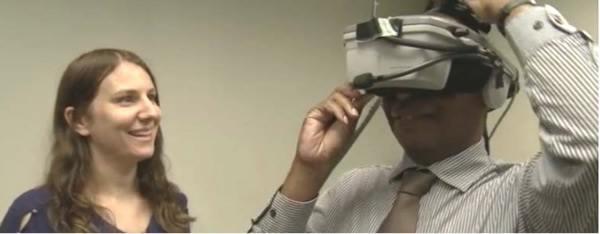Last updated: May 10, 2016
April 5 2016 Virtual Reality Technology In Social And Behavioral Research
Virtual Reality Technology in Social and Behavioral Research
April 5, 2016
NHGRI's Intramural Research Program houses unique investigative endeavors of various types. One such enterprise is the Immersive Virtual Environment Test Unit, which encompasses the Immersive Virtual Testing Area (IVETA). Founded in 2006, IVETA is an experimental behavioral science research laboratory within the NIH Clinical Center that serves the NHGRI Social and Behavioral Research Branch (SBRB). The focus of IVETA is the development of advanced communications methodologies and technologies for use in behavioral research.

IVETA provides expertise, tools, and assistance to investigators who seek to integrate technologically-based behavioral research tools into their studies. The laboratory develops virtual-reality worlds for helping to answer research questions posed by SBRB investigators, and has recently expanded its scope to collaborate with other NIH researchers. IVETA's head is Dr. Susan Persky, who arrived at NHGRI in 2009. The laboratory uses innovative technologies, such as immersive virtual reality, for research projects that aim to advance knowledge at the intersections of genomics, human behavior, and society.

Dr. Susan Persky helps a volunteer using IVETA technology.
Dr. Persky and her collaborators are exploring how new genomic knowledge influences the interactions between healthcare providers and patients, as well as in other social circumstances. The IVETA technology uses virtual reality to simulate healthcare situations, examining how genomic information affects healthcare communication, relationships between healthcare providers and patients, medical decision-making, and peoples' emotions and behavior.
More specifically, IVETA simulates clinical visits through the use of virtual-reality healthcare providers or patients. The simulations allow researchers to vary elements that they would like to study; for example, health disparities can be investigated by varying the race or ethnicity of the healthcare provider or patient, and the reactions of the test subject (who is in the other role) can be measured. In one study focusing on obesity, IVETA has been used as a behavioral measure for parents by allowing them to pick food for their children from a virtual-reality buffet and then measuring responses. This same approach could also be used to design a simulation for measuring a patient's own food choices.
In another example, a virtual-reality classroom was created to assess attention performance among children with Attention Deficit Hyperactivity Disorder. Such a simulation allowed researchers to administer realistic but controlled distractions (e.g., a bus driving by outside or a classmate whispering to another child at pre-determined intervals) while child subjects were being studied. Researchers were also able to determine where in the classroom the child was looking throughout the assessment. Analyses of the data collected through this work are ongoing.

From left to right: Virtual doctor, virtual buffet and virtual patient.
This past year, the IVETA team undertook an initiative to widen the behavioral research tools being made available to investigators. They engaged in a horizon-scanning exercise and also held a series of meetings to discuss potential areas for expansion. In these meetings, they engaged both SBRB stakeholders as well as experts in behavioral science and information technology. Based on this effort, IVETA plans to expand its capacity to allow for other measurements that might complement wearable biosensors (such as those that capture participants' real-time cardiovascular activity). Additionally, the IVETA team is now evaluating the possible addition of automated analyses of facial expressions using webcam technology.
It is exciting to have something as novel as IVETA in NHGRI's Intramural Research Program. There are very few such 'immersive virtual reality' behavioral research laboratories in the world, and none that additionally focus on genomics. For more information about our IVETA program, see genome.gov/27559802/persky-scientific-summary/.
Posted: May 10, 2016
